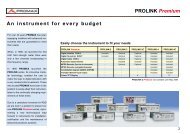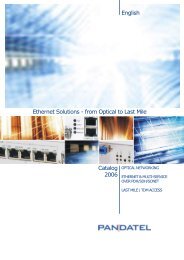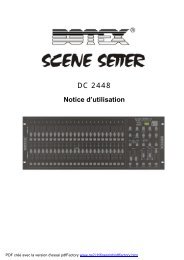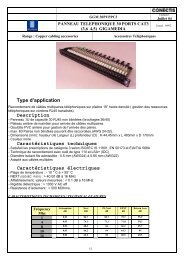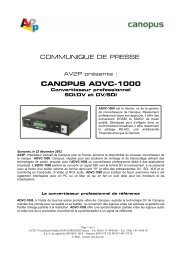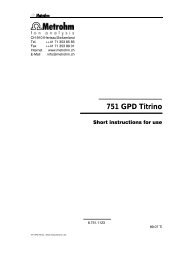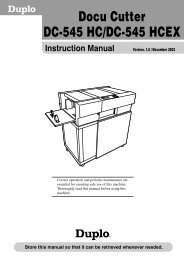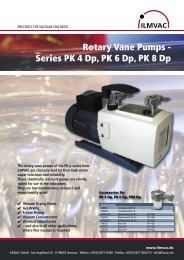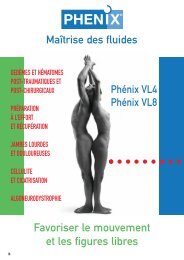Simple measurements
Simple measurements
Simple measurements
- No tags were found...
Create successful ePaper yourself
Turn your PDF publications into a flip-book with our unique Google optimized e-Paper software.
Leica Theodolite 100 SeriesUser Manual T105/T110Version 1.3English
Electronic TheodoliteCongratulations on your purchase of a new LeicaGeosystems Theodolite.The type and the serial number of your instrumentindicated on the label in the battery compartment.Write the type and serial number of your instrument in thespace provided below, and always quote this informationwhen you need to contact your agency or serviceworkshop.Type:This manual contains important safety directions(refer to section "Safety directions") as well asinstructions for setting up the instrument andoperating it.Please read this User Manual carefully to achievemaximum efficiency from yourInstrument.Product identificationSerial no.:Symbols used in this manualThe symbols used in this User Manual have the followingmeanings:DANGER:Indicates an imminently hazardous situationwhich, if not avoided, will result in death orserious injury.WARNING:Indicates a potentially hazardous situation or anunintended use which, if not avoided, could resultin death or serious injury.CAUTION:Indicates a potentially hazardous situation or anunintended use which, if not avoided, may resultin minor or moderate injury and / or appreciablematerial, financial and environmental damage.Important paragraphs which must be adhered toin practice as they enable the product to be usedin a technically correct and efficient manner.2 T105/T110-1.3.0en
View of chaptersIntroductionOperating the Instrument<strong>Simple</strong> <strong>measurements</strong>ConfigurationSafety DirectionsCare and StorageAccessoriesMessages and WarningsTechnical Data61012303950565759T105/T110-1.3.0enIndex3View of chapters61
ContentsIntroduction ................................................... 6Special features ........................................................... 6Important parts ............................................................ 7Technical terms and abbreviations ............................... 8Operating the Instrument ........................... 10Keyboard .................................................................. 10Buttons ...................................................................... 11AutoOff ...................................................................... 11<strong>Simple</strong> <strong>measurements</strong> ................................ 12Unpacking ................................................................. 12Batteries.................................................................... 13Inserting / Replacing Battery ...................................... 14Setting up the tripod ................................................... 16Centring with Laser Plummet, Coarse Level-Up ......... 17Laser intensity ........................................................... 18Centring with shiftable tribrach ................................... 18Hints for positioning ................................................... 19Accurate levelling-up with electronic level ................... 19Measuring ................................................................. 20Setting Hz-direction ........................................................ 21Setting Hz-circle ............................................................. 21V-angle display ............................................................... 21Measuring Hz-angle .................................................. 22Measuring V-angle .................................................... 23Extending straight lines .............................................. 24Staking out vertical lines ............................................ 25Distance measuring with stadia lines .......................... 26Instrument errors ....................................................... 27Line-of-sight error (Hz-collimation) .................................. 27V-Index (Vertical index error) ........................................... 27Determining the line-of-sight error (c) .............................. 28Determining V-index ....................................................... 29Configuration ............................................... 30Setting the beep ........................................................ 31Setting V-angle .......................................................... 32Setting display contrast .............................................. 33Setting the angle units ............................................... 34V - % .............................................................................. 35Displayed angle format .............................................. 36Switching on/off compensator .................................... 37Switching on/off line-of-sight error correction .............. 38Contents4 T105/T110-1.3.0en
Contents, contd.Safety Directions ......................................... 39Intended use of instrument ........................................ 39Permitted uses ............................................................... 39Adverse uses .................................................................. 39Limits of use .............................................................. 40Responsibilities ......................................................... 40Hazards of use .......................................................... 41Main hazards of use ....................................................... 41Laser classification .................................................... 45Laser plummet ................................................................ 45Electromagnetic acceptability (EMV) .......................... 48FCC statement (applicable in U.S.) ............................ 49Accessories ................................................. 56Messages and Warnings ............................ 57Technical Data ............................................. 59Index ............................................................. 61Care and Storage......................................... 50Transport .................................................................. 50In the field ....................................................................... 50Inside vehicle .................................................................. 51Shipping ......................................................................... 51Storage ..................................................................... 51Cleaning ......................................................................... 52Checking and adjusting ............................................. 53Tripod ............................................................................. 53Circular level ................................................................... 53Circular level on the tribrach ........................................... 53Laser plummet ................................................................ 54Reticle ............................................................................ 55T105/T110-1.3.0en5Contents
IntroductionThe Leica T105/T110 is a high-qualityelectronic theodolite designed for theconstruction site.Its innovative technology makes thedaily surveying jobs easier.The instrument is ideally suited forsimple construction surveys andsetting out tasks.The easy operation of the instrumentfunctions can be quickly learned evenby inexperienced surveyors.Special features• Easy and quickly to learn !• Logically designed keyboard; withlarge and clear LCD.• Attractive design; low weight.• User setting remain active evenafter switching off.• Continuous drives for horizontaland vertical angles.• AutoOFF function to preventunneccary power consumption.T105• Equipped with laser plummet asstandard.T100z01Introduction6 T105/T110-1.3.0en
Important parts1 2 3 4 5 6 7 8 91 Optical sight2 Telescope3 Vertical drive4 Battery GEB111 (optional)5 Battery spacer for GEB1116 Battery holder for GEB111/GEB121/GAD397 Focussing graticule8 Focussing telescope image9 Detachable carrying handle withmounting screws10 Foot screw11 Objective12 Battery adapter GAD39 for 6single cells (optional)13 Battery GEB121 (optional)14 Display15 Keyboard16 Circular level17 Horizontal drive10 11 12 13 14 15 1617T100Z02T105/T110-1.3.0en7Introduction
Technical terms and abbreviationsKASASAZAKAKAVKHKSASAVHz0HzZAT100Z24ZA = Line of sight / collimationaxisLine in space containing all objectpoints imaged into the graticulecentre at different distance settingsfrom ¥ to very near.SA = Standing axisVertical rotation axis of the telescopeenables measuring of Hz-angles.KA = Tilting axisHorizontal rotation axis of thetelescope enables measuring of V-angles.V = Vertical angle / zenith angleVK = Vertical circleWith coded circular division forreading the V-angle.Hz = Horizontal angleHK = Horizontal circleWith coded circular division forreading the Hz-angle.Hz0 = Horizontal circle reading 0°(0 gon)Introduction8T105/T110-1.3.0en
Operating the InstrumentKeyboardT100Z26ON/OFF keysSwitches instrument ONSwitches instrument OFFby pressing both keyssimultaneously.Operating Introduction the InstrumentCombi keyCalling quick setting forcompensator, beep anddisplay contrast.Function keysSwitching on/off laserplummet; setting laserintensitySwitching on/off displayillumination and heating(active under -5°C; isdisplayed)Switching on/off electroniclevel. The laser plummet isactivted simultaneously10Angle keysSetting the horizontal angleand Hz0.Setting the Hz-angle right orleft.Switching the vertical angle Von/off; selecting the displayunit (% or V).Key combinationsAccess to the second keyassignment of the angle keys isenabled.+++Determining line-ofsighterror.Determining verticalindex error.Activating configurationmenu.T105/T110-1.3.0en
ButtonsAutoOffImportant buttons:Confirms settings; back intomeasuring mode.Paging through menu (e.g.within the configuration).Selection of a setting.The active selection is alwaysindicated in the left part of thedisplay.The instrument is equipped with anautomatic switching off function.Is activated when:• battery low,• no action is carried out with theinstrument for 1/3 hour (= no keypressed; V and Hz angle deviation£ ±3' / ±600cc).The function AutoOff cannotbe deactivated.A button is a symbol in the displaywhich is always assigned to afunction key directly below it. Buttonscan be found mainly in theconfiguration menu.Find more and detailledinformation about buttons inthe relevant sections.T105/T110-1.3.0en11Operating the Introduction Instrument
<strong>Simple</strong> <strong>measurements</strong>UnpackingRemove T105/T110 from transport case and check for completeness:1/2345678910T100Z311 Allen key (2x)2 Adjusting pins (2x)3 Removable tribrach GDF101 /Shiftable tribrach GUS75 (optional)4 Battery charger and accessories(optional)5 Battery GEB111 (optional)6 GHT196 Spacing Bracket (optional)7 GHM007 Instrument HeightMeter (optional)8 Theodolite9 User Manual10 Protective cover / Lens hood<strong>Simple</strong> Introduction <strong>measurements</strong>12T105/T110-1.3.0en
BatteriesT100z79Use the Leica Geosystemsbatteries, chargers andaccessories or accessoriesrecommended by LeicaGeosystems to ensure thecorrect functionality of theinstrument.812GEB121GEB111Individual cells in thebattery adapter GAD39Your Leica Geosystems instrument isoperated with rechargable plug-inbatteries. The Basic battery(GEB111) or the Pro battery(GEB121) is recommended for T105/T110 instruments. As an option, sixindividual cells can be used with theappropriate battery adapter GAD39.Six individual cells (1.5 V each)produce a voltage of 9 Volts. Thebattery indicator in the display isdesigned for a voltage of 6 Volts(GEB111/GEB121). For this reasonthe charge state of individual cells isnot indicated correctly. The batteryadapter with individual cells shouldtherefore be used as a backup. Theadvantage of individual cells is thelow self-discharge rate - even overlonger periods of time.T105/T110-1.3.0en13<strong>Simple</strong> <strong>measurements</strong>
Inserting / Replacing Battery, continuedInsert battery correctly (notepole markings on the insideof the battery cover). Check andinsert battery holder true to side intothe housing.• For type of battery see section"Technical Data".If the battery GEB121 or thebattery adapter GAD39 forsix individual cells is used, the spacerfor the GEB111 must be removedfrom the battery holder prior toinserting the battery.812T100Z064. Insert battery holder intoinstrument.T105/T110-1.3.0en15<strong>Simple</strong> <strong>measurements</strong>
Setting up the tripod8T100Z58121. 1.T100Z32T100Z33T100Z57T100Z192.1.2.2.1. Loosen screws of tripod legs, pullout to required length and tightenscrews.2. In order to guarantee a firmfoothold sufficiently press thetripod legs into the ground.When pressing the legs into theground note that the force must beapplied along the legs.When setting up the tripodpay attention to a horizontalposition of the tripod plate.Heavy inclinations of the tripod mustbe corrected with the footscrews ofthe tribrach.Careful handling of tripod• Check all screws and bolts forcorrect fit.• During transport always use thecover supplied.Scratches and other damages canresult in poor fit and measuringinaccuracies.• Use the tripod only for surveyingjobs.<strong>Simple</strong> <strong>measurements</strong>16T105/T110-1.3.0en
Centring with Laser Plummet, Coarse Level-Up1.3.1.4.8.8125. 5.7.5. 8.6.8.T100Z076.5.6.T100Z087.8.T100Z091. Place the instrument onto thetripod head.Tighten central fixing screw oftripod slightly.2. Turn footscrews of tribrach into itscentre position.3. Switch on the instrument with .4. Switch on laser plummet with. The electronic levelappears in the display.5. Position tripod legs so that thelaser beam is aimed to the groundpoint.6. Firmly press in tripod legs.7. Turn the footscrews of the tribrachto centre the laser beam exactlyover the ground point.8. Move the tripod legs to centre thecircular level. The instrument isnow roughly levelled-up.T105/T110-1.3.0en17<strong>Simple</strong> <strong>measurements</strong>
812MeasuringAfter switching on and setting upcorrectly, the instrument isimmediately ready for measuring.Depending on setting the following display appears:Display 1 Display 2H: 123°12'50" H: 123°12'50"V: 90°00'30"• Hz-angle in the unit selected (seechapter "Configuration / Angleunits")• battery conditionis indicated.• Hz-angle in the unit selected• V-angle in the unit selected andthe setting concerning zenith V orhorizon V (see chapter"Configuration / Setting V-angle")• battery conditionis indicated.<strong>Simple</strong> <strong>measurements</strong>20T105/T110-1.3.0en
812Extending straight linesWanted: The straight line from A to B should be extended. A new point C is created.SIMPLE methodACCURATE method3.C4.5. C1 C5. C22.A4.ABT100Z14BT100Z15Procedure:1. Set up instrument above point A and level up.2. Aim on point B in face one.3. Turn telescope around the tilt axis and stake-out pointC1 in the desired distance.To ensure accuracy:distance A-C » distance A-BProcedure:Carry out steps 1 to 3 (see SIMPLE method).4. Turn instrument around the standing axis and aim onpoint B again.5. Turn telescope around the tilt axis and stake-out anauxiliary point C2 in the same distance as C1.Result:Point C is in the middle of line C1 to C2.<strong>Simple</strong> <strong>measurements</strong>24T105/T110-1.3.0en
Staking out vertical linesWanted: Point C should be staked out vertically over B.8SIMPLE methodACCURATE methodC13.C2CC1 5.123.B2.C5.B4.4.4.AT100Z47AT100Z48Procedure:1. Set up instrument at any point A. It must be possible toaim on B and C1 easily.2. Level up instrument and aim on point B.3. Swivel telescope upwards and mark centre oftelescope (C1) in the desired height.Procedure:Carry out steps 1 to 3 (see SIMPLE method).4. Change to face two and aim on point B again.5. Swivel telescope upwards and mark centre oftelescope (C2) again in the desired height.Result: Point C is in the middle of the twomarkings C1 and C2.T105/T110-1.3.0en25<strong>Simple</strong> <strong>measurements</strong>
812Distance measuring with stadia linesWanted: Horizontal distance between station and target point.SIMPLE methodT100Z12aiAV » 90°/100 gon1.;;;;;;Procedure:1. Set up instrument above point Aand level up.2. Erect levelling staff exactly verticalon point B.3. Aim on staff (z=i) and read staffsection L.DResult:D = 100 x L3.B2.z16141715Reading:Upper distance line: 166.2Lower distance line: 150.0Difference L: 16.2Difference L in [cm] equals distanceD in [m]LT100Z12bACCURATE methodT100Z12ciVD;;AProcedure:Carry out steps 1 and 2 (see SIMPLEmethod).3. Aim on staff (z=i) and read staffsection L. Simultaneously, takedown zenith angle V.3.;;;;;Result:D = 100 x L x sin²VBz<strong>Simple</strong> <strong>measurements</strong>26T105/T110-1.3.0en
Instrument errorsLine-of-sight error (Hz-collimation)V-Index (Vertical index error)The instruments are adjusted in thefactory prior to shipping.Index-errors and line-of-sight errorscan change with time andtemperature.Ci812These errors should bedetermined before theinstrument is used for the firsttime, before precisionsurveys, after long periods oftransport, before and afterlong periods of work, and ifthe temperature changes bymore than 10°C (18°F).The line-of-sight error or collimationerror (C) is the deviation from theperpendicular between the tilting axisand the line of sight.The effect of the line-of-sight error tothe Hz-angle increases with thevertical angle.For horizontal aimings the error of Hzequals the line-of-sight error.T100Z16The vertical circle should readexactly 90° (100 gon) when the lineof sight is horizontal. Any deviationfrom this figure is termed verticalindex error (i).T100Z13T105/T110-1.3.0en27<strong>Simple</strong> <strong>measurements</strong>
Determining the line-of-sight error (c)8121. Level up instrument exactly usingthe electronic level.2. Aim at a point approximately 100mfrom the instrument wich is lessthan 5° from the horizontal. Checkby activating the V-angle display.3. Start calibration by pressingand simultaneously.4. Measure Hz-angle with .orback to measuring menu withwithout modification.H: 123°12'50"V: 90°04'14"c: 0°00'08"ca. 100 m5. Change telescope position andaim at the point again.6. Again measure Hz-angle withline-of-sight error is computed.180°± 5°180°T100Z18T100Z17Keep actual value.Accept new computed value(arrow).c: -0°00'08"c: -0°00'12"<strong>Simple</strong> <strong>measurements</strong>28T105/T110-1.3.0en
Determining V-index1. Level up instrument exactly usingthe electronic level.2. Aim at a point approximtely 100mfrom the instrument which is lessthan 5° from the horizontal. Checkby activating the V-angle display.3. Start calibration by pressingand simultaneously.4. Measure V-angle with .orback to measuring menu withwithout modification.H: 123°12'50"V: 90°04'14"i: 0°00'15"812ca. 100 m5. Change telescope position andaim on point again.6. Again measure V-angle withvertical index error is computed.180°± 5°180°T100Z18By determining the verticalindex error the electroniclevel is adjustedautomatically.T100Z17Keep actual value.Accept new computed value(arrow).i: -0°00'15"i: -0°00'10"T105/T110-1.3.0en29<strong>Simple</strong> <strong>measurements</strong>
81215ConfigurationQuick setting+ Configuration menuSelect parameterChange settingQuitImmediate access to functions:- compensator (on/off)- beep (on/off/90°)- display contrastAfter pressing the keys simultaneously the following parameters can beselected:beepsetting V-angledisplay contrast360 sangle unitsindicated angle formatcompensatorC line-of-sight error correctionSelecting the configuration parametersSelected setting is displayed in the left display halfQuit and set the settingAll settings remain active even after switching off.The quick setting is an extract from the completeconfiguration.Configuration<strong>Simple</strong> <strong>measurements</strong>30T105/T110-1.3.0en
Setting the beepThe beep is an acoustic signal aftereach key stroke or at right angles.Switch on beep:1. Scroll to symbol/ /2. Select "Beep ON" with .3. Confirm selection with .Example:From 95.0 to 99.5 gon (or from 105.0to 100.5 gon) a "Fast beep" and from99.5 to 99.995 gon (or from 100.5 to100.005 gon) a "Permanent beep"sounds.8121511The setting of the beep can bechanged via the configuration menuor directly via the quick setting.Switch off beep:Same procedure but select .Switch on 90° beep for right anglestake-outs:T100Z27213 32Possible settings:Same procedure but select .Beep is switched ON.Beep is switched OFF.The beep sounds at right angles (0°,90°, 180°, 270° or 0, 100, 200, 300gon).1 1Beep is switched ON andsounds at right angles.1 No beep2 Fast beep3 Permanent beepT105/T110-1.3.0en31Configuration
Setting V-angle812The "0"- orientation of the verticalcircle can be either selected for thezenith or the horizontal plane.V-angle "0" for the horizontalplane :V-angle "0" for the zenith :1. Scroll to symbol /152. Select desired option with3. Confirm selection with .T100Z29T100Z28The setting is valid for allangle units and can only bechanged via the configurationmenu.V-angles above the horizontal planeare indicated as positive values andbelow the horizontal plane as negativevalues. Up to the maximum valueof 180° (200 gon) the V-angledecreases/increases.The V-anlge increases from 0° - 360°(0 - 400 gon).Configuration32T105/T110-1.3.0en
Setting display contrastThe readability of LCDs is influencedby external conditions (temperature,lighting) and by the reading angle.The display contrast can be adaptedstep by step until a perfect readabilityis reached.1. Scroll to symbolSetting of the contrast in five steps:MinimumContrast 1/4Contrast 1/28121511Contrast 3/4MaximumT100Z302. Select setting with3. Confirm selection withThe actual setting is indicated andthe desired display contrast is set.The display contrast isimmediately adjusted duringthe setting.The contrast setting can be changedvia the configuration menu or directlyvia the quick setting.T105/T110-1.3.0en33Configuration
81215Setting the angle unitsThe setting of the angle units can bechanged at any time.The actual values are convertedaccording to the selected unit.Setting of the angle units can only bechanged via the configuration menu.1. Scroll to symbol360s / 360d / gon / mil.Possible settings:• 360s (degree sexagesimal)possible angle values:0° to 359°59'59''• gonpossible angle values:0g to 399.999 gonH: 123°12'53" H: 154.209 gon360s360s 360d gon mil• 360d (degree decimal)possible angle values:0° to 359.999°• milpossible angle values:0 to 6399.99mil2. Select desired option with3. Confirm selection with .H: 123.209° H: 2190.06 milConfiguration34T105/T110-1.3.0en
V - %100% correspond to an angle of 45°(50 gon, 1600 mil).8--.--%71°34'+ 300%45°+ 100%The % value increases rapidly as theline of sight moves away from the horizontal.That´s why "--.--%" appears on thedisplay at approx. 70° (80 gon).12151120°+ 18%360sgon0°± V--.--%-50 gon- 100%-79.5 gon- 300%T100Z46T105/T110-1.3.0en35Configuration
Displayed angle format81215The displayed angle format can beselected in three steps (1, 5 or 10)and only changed via theconfiguration menu.1. Scroll to symbolPossible settings:For 360°'":1 => 0° 00' 01"5 => 0° 00' 05"10 => 0° 00' 10"Always " are indicated.For gon:1 => 0.001 gon5 => 0.005 gon10 => 0.010 gonAlways three decimals are indicated.11 5 10H: 123°12'53" H: 154.209 gon2. Select desired option with3. Confirm selection withFor 360°:1 => 0.001°5 => 0.005°10 => 0.010°Always three decimals are indicated.For mil:1 => 0.01 mil5 => 0.05 mil10 => 0.10 milAlways two decimals are indicated.In the following examplesalways the option indicated inItalics is shown.H: 123.209° H: 2190.06 milConfiguration36T105/T110-1.3.0en
Switching on/off compensatorThe compensator normaly remainsswitched on.If the instrument is used on anunstable base (e.g. shaking platform,ship, etc.) the compensator mustbe switched off.This avoids the compensator driftingout of it's measuring range andinterupting the measuring process byindicating an error.The working range of thecompensator is at 5'24" (±0.1gon).This horizontal accuracy can is easilyobtained with the electronic level.1. Scroll to symbol / Possible settings:2. Select desired option with3. Confirm setting with .The compensator is switchedON. V-angles relate to theplumb line.The compensator is switchedOFF. V-angles relate to thestanding axis.The compensator settingremains active even after theinstrument is switched off.8121511T105/T110-1.3.0en37Configuration
Switching on/off line-of-sight error correction81215The T105/T110 can correct the lineof-sighterror (Hz-collimation)automatically. This setting can onlybe changed via the configurationmenu.If option "Line-of-sight errorcorrection ON" is active, eachmeasured Hz-angle is corrected(depending on V-angle).1. Scroll to symbol C / CCC CBy measuring in both facesthe line-of-sight error iseliminated.Find more information aboutthe Hz-collimation in chapter"Determining instrumenterrors".For normal operation the line-of-sighterror correction remains switched on.2. Select desired option with3. Confirm setting withPossible settings:CThe line-of-sight errorcorrection is switched ON.CThe line-of-sight errorcorrection is switched OFF.Configuration38T105/T110-1.3.0en
Safety DirectionsIntended use of instrumentThe following directions shouldenable the person responsible for theT105/T110, and the person whoactually uses the instrument, toanticipate and avoid operationalhazards.The person responsible for theinstrument must ensure that all usersunderstand these directions andadhere to them.Permitted usesThe electronic total stations areintended to the following applications:• Measuring horizontal and verticalangles• Visualising the standing axis (withlaser plummet)Adverse uses• Use of the total station withoutprevious instruction• Use outside of the intended limits• Disabling safety systems• Removal of hazard notices• Opening the instrument using tools(screwdriver, etc.), unless this isspecifically permitted for certainfunctions8121531• Modification or conversion of theinstrument• Use after misappropriation• Use with accessories from othermanufacturers without the prior expressapproval of Leica Geosystems• Aiming directly into the sun• Inadequate safeguards at thesurreying site (e.g. whenmeasuring on roads, etc.)T105/T110-1.3.0en39Safety directions
Adverse uses, contd.Limits of useResponsibilities8121531WARNING:Adverse use can lead toinjury, malfunction, and materialdamage.It is the task of the personresponsible for the instrument toinform the user about hazards andhow to counteract them. Theelectronic total stations are not to beused until the user has been properlyinstructed how to use them.Environment:Suitable for use in an atmosphereappropriate for permanent humanhabitation: not suitable for use in aggressiveor explosive environments.Use in rain is permissible for limitedperiods.Refer to section "Technical Data".Area of responsibility for themanufacturer of the originalequipment Leica Geosystems AG,CH-9435 Heerbrugg (hereinafterreferred to as Leica Geosystems):Leica Geosystems is responsible forsupplying the product, including theuser manual and originalaccessories, in a completely safecondition.Responsibilities of themanufacturers of non-Leicaaccessories:The manufacturers of non-Leica accessories for theT105/T110 electronic total stationsare responsible for developing,implementing and communicatingsafety concepts for their products,and are also responsible for theeffectiveness of those safetyconcepts in combination with the LeicaGeosystems product.Safety directions40T105/T110-1.3.0en
Hazards of useResponsibilities of the person incharge of the instrument:WARNING:The person responsible forthe instrument must ensurethat it is used in accordance with theinstructions. This person is alsoaccountable for the training anddeployment of personnel who use theinstrument and for the safety of theequipment when in use.The person in charge of theinstrument has the following duties:• To understand the safetyinstructions on the product and theinstructions in the User Manual.Main hazards of useWARNING:The absence of instruction,or the inadequate impartingof instruction, can lead to incorrect oradverse use, and can give rise toaccidents with far-reaching human,material, financial and environmentalconsequences.Precautions:All users must follow the safetydirections given by the manufacturerand the directions of the personresponsible for the instrument.WARNING:Using a battery charger notrecommended by LeicaGeosystems can destroy thebatteries. This can cause fire orexplosions.Precautions:Only use chargers recommended byLeica Geosystems to charge thebatteries.8121531• To be familiar with local regulationsrelating to accident prevention.• To inform Leica Geosystemsimmediately if the equipmentbecomes unsafe.T105/T110-1.3.0en41Safety directions
Main hazards of use, contd.8CAUTION:DANGER:WARNING:121531Watch out for erroneous<strong>measurements</strong> if theinstrument is defective or if it hasbeen dropped or has been misusedor modified.Precautions:Periodically carry out test<strong>measurements</strong> and perform the fieldadjustments indicated in the UserManual particularly after theinstrument has been subjected to abnormaluse and before and afterimportant <strong>measurements</strong>.Because of the risk ofelectrocution, it is verydangerous to use reflector poles andextensions in the vicinity of electricalinstallations such as power cables orelectrical railways.Precautions:Keep at a safe distance fromelectrical installations. If it is essentialto work in this environment, firstcontact the safety authoritiesresponsible for the electricalinstallations and follow theirinstructions.By surveying during athunderstorm you are at riskfrom lightening.Precautions:Do not carry out field surveys duringthunderstorms.CAUTION:Be careful not to point theinstrument directly towardsthe sun, because the telescopefunctions as a magnifying lens andcan injure your eyes.Precautions:When viewing into the sun or againstbright objects only use suitableaccessories for this purpose.Safety directions42T105/T110-1.3.0en
Main hazards of use, contd.WARNING:During target recognition orstakeout procedures there isa danger of accidents occurring if theuser does not pay attention to the environmentalconditions around orbetween the instrument and thetarget (e.g. obstacles, excavations ortraffic).Precautions:The person responsible for theinstrument must make all users fullyaware of the existing dangers.WARNING:Inadequate securing of thesurveying site can lead todangerous situations, for example intraffic, on building sites and atindustrial installations.Precautions:Always ensure that the surreying siteis adequately secured. Adhere to thelocal regulations governing accidentprevention and road traffic.CAUTION:If a target lamp accessory isused with the instrument thelamp's surface temperature may beextreme after a long working period.It may cause pain if touched.Replacing the halogen bulb beforethe lamp has been allowed to cooldown may cause burning to the skinor fingers.Precautions:Use appropriate heat protection suchas gloves or woollen cloth beforetouching the lamp, or allow the lampto cool down first.CAUTION:If the accessories used withthe instrument are notproperly secured, and the equipmentis subjected to mechanical shock(e.g. blows, falling etc.), theequipment may be damaged safetydevices may be ineffective or peoplemay sustain injury.Precautions:When setting-up the instrument,make sure that the accessories (e.g.tripod, tribrach, etc.) are correctlyadapted, fitted, secured and locked inposition.Avoid subjecting the equipment tomechanical shock.Never position the instrument on thetripod baseplate without securelytightening the central fixing screw. Ifthe screw is loosened always removethe instrument immediately from thetripod.8121531T105/T110-1.3.0en43Safety directions
Main hazards of use, contd.8121531WARNING:If the equipment isimproperly disposed of, thefollowing can happen:• If polymer parts are burnt,poisonous gases are producedwhich may impair health.• If batteries are damaged or areheated strongly, they can explodeand cause poisoning, burning,corrosion or environmentalcontamination.• By disposing of the equipmentirresponsibly you may enableunauthorized persons to use it incontravention of the regulations,exposing themselves and thirdparties to the risk of severe injuryand rendering the environmentliable to contamination.• Leakage of silicone oil from thecompensator can damage theoptical and electronic subassemblies.Precautions:Dispose of the equipmentappropriately in accordance with theregulations in force in your country.Always prevent access to theequipment by unauthorizedpersonnel.CAUTION:During the transport ordisposal of charged batteriesit is possible for inappropriatemechanical influences to constitute afire hazard.Precautions:Before transporting or disposing ofequipment, discharge the battery(e.g. by running the instrument intracking mode until the batteries areexhausted.Safety directions44T105/T110-1.3.0en
Laser classificationLaser plummetCAUTION:Allow only authorized LeicaGeosystems serviceworkshops to service the instrument.The integrated laser plummetproduces a visible laser beam whichemerges from the base of theinstrument.The product is a Class 2 laserproduct in accordance with:• IEC 60825-1:1993 "Radiationsafety of laser products".• EN 60825-1:1994 + A11:1996"Radiation safety of laserproducts".Class 2/II laser products:Do not stare into the beam or direct itunnecessarily at other persons. Eyeprotection is normally afforded byaversion responses including theblink reflex.8121531The product is a Class II laserproduct in accordance with:• FDA 21CFR Ch.I §1040: 1988 (USDepartment of Health and HumanService, Code of Federal Regulations)T105/T110-1.3.0en45Safety directions
Laser plummet, contd.8Labelling1215/$6(55$',$7,21'212767$5(,172%($0QPP:PD[&/$66,,/$6(5352'8&721/4s31$92,'(;32685(/DVHUUDGLDWLRQLVHPLWWHGIURPWKLVDSHUWXUHT100Z78Laser RadiationDo not stare into beamClass 2 Laser Productaccording to IEC 60825-1:1993P 0£ 0.95 mWl = 620 - 690 nmSafety directions46T105/T110-1.3.0en
Laser plummet, contd.Type: T... Art.No.: ......Power: 12V/6V ---, 1A maxLeica Geosystems AGCH-9435 HeerbruggManufactured:1998Made in Switzerland S.No.: ......This laser product complies with 21CFR 1040as applicable.This device complies with part 15 of the FCCRules. Operation is subject to the following twoconditions: (1) This device may not cause harmfulinterference, and (2) this device must acceptany interference received, including interferencethat may cause undesired operation.Beam divergence0.16 x 0.6 mradImpulse durationc.w.Maximum power output0.95 mWMeasurement uncertainty ±5%8121531T100Z54Laser beam(visible)Laser beam (visible)exitT100Z56T105/T110-1.3.0en47Safety directions
Electromagnetic acceptability (EMV)8121531The term "electromagneticacceptability" is taken to mean thecapability of the instrument tofunction correctly in an environmentwhere electromagnetic radiation andelectrostatic discharges are present,and without causing electromagneticdisturbances in other equipment.WARNING:Electromagnetic radiationcan cause disturbances inother equipment.Although electronic teodolites meetthe strict regulations and standardswhich are in force in this respect, Leicacannot completely exclude thepossibility that other equipment maybe disturbed.CAUTION:There is a risk thatdisturbances may be causedin other equipment if the teodolite isused in conjunction with accessoriesfrom other manufacturers (e.g. personalcomputers, walkie-talkies, ...).Precautions:Use only the equipment andaccessories recommended by LeicaGeosystems. When combined withteodolites, they meet the strictrequirements stipulated by theguidelines and standards. Whenusing computers and walkie-talkies,pay attention to the information aboutelectromagnetic compatibilityprovided by the manufacturer.CAUTION:Disturbances caused byelectromagnetic radiation canresult in the tolerance limits for<strong>measurements</strong> being exceeded.Although the teodolites meet thestrict regulations and standardswhich are in force in this connection,Leica Geosystems cannot completelyexclude the possibility that theteodolite may be disturbed by veryintense electromagnetic radiation,e.g. near radio transmitters, walkietalkies,diesel generators, powercables.Check the plausibility of resultsobtained under these conditions.Safety directions48T105/T110-1.3.0en
FCC statement (applicable in U.S.)WARNING:This equipment has been tested and found tocomply with the limits for a Class B digital device,pursuant to part 15 of the FCC Rules.These limits are designed to provide reasonableprotection against harmful interference in a residentialinstallation.This equipment generates, uses and can radiatefrequency energy and, if not installed and used inaccordance with the instructions, may cause harmfulinterference to radio communications.However, there is no guarantee that interference will notoccur in a particular installation.WARNING:Changes or modifications not expressly approvedby Leica Geosystems for compliance could voidthe user's authority to operate the equipment.Product labelling:This device complies with part 15 of the FCC Rules.Operation is subject to the following two conditions:(1) This device may not cause harmful interference, and(2) this device must accept any interference received,including interference that may cause undesired operation.8121531If this equipment does cause harmful interference to radioor television reception, which can be determined byturning the equipment off and on, the user is encouragedto try to correct the interference by one or more of thefollowing measures:• Reorient or relocate the receiving antenna.• Increase the separation between the equipment andreceiver.• Connect the equipment into an outlet on a circuitdifferent from that to which the receiver is connected.• Consult the dealer or an experienced radio/TVtechnician for help.This device complies with part 15 ofthe FCC Rules. Operation is subjectto the following two conditions:(1) This device may not cause harmfulinterference, and (2) this device mustaccept any interference received,including interference that may causeundesired operation.1000Z77T105/T110-1.3.0en49Safety directions
81215Care and StorageTransportWhen transporting or shipping theequipment always use the originalLeica Geosystems packaging(transport case and shippingcardboard).In the field3141After a longer period ofstorage or transport of yourinstrument always check thefield ajustment parametersindicated in this manualbefore using the instrument.T100Z21T100Z36When transporting the equipment inthe field, always make sure to• either carry the instrument in itsoriginal transport case or,• carry the tripod with its legssplayed across your shoulder,keeping the attached instrumentupright.Care and storage50T105/T110-1.3.0en
Inside vehicleShippingStorageT100Z70+158°°F °C+70°8120°0°15T100Z71-40°-40°T100Z613141Never transport the instrument looseinside the vehicle.The instrument can be damaged byblows and vibrations. It must alwaysbe transported in it's case and beproperly secured.For shipping the instrument by rail,aircraft or ship use the LeicaGeosystems original packaging(transport case or shippingcardboard) or another suitablepackaging securing the instrumentagainst blows and vibrations.When storing the equipment,particularly in summer andinside a vehicle, take thetemperature limits into account.When storing the intrument inside abuilding also use the transport case(if possible, in a safe place).T105/T110-1.3.0en51Care and storage
Cleaning812153141If the instrument becomeswet, leave it unpacked.Wipe down, clean, and dry theinstrument (at not more than 40 °C/108°F), transport case, foam inserts,and accessories. Pack up theequipment only when it is perfectlydry.When using the instrument in thefield always close the transport case.T100Z66Objective, eyepiece andprisms:• Blow dust off lenses and prisms• Never touch the glass with fingers• Use only a clean, soft and lint-freecloth for cleaning. If necessary,moisten the cloth with purealcohol.Use no other liquids; these mayattack polymer components.T100Z67Care and storage52T105/T110-1.3.0en
Checking and adjustingTripodCircular levelCircular level on the tribrach81 2121531T100z43T100z44T100z4541The connections between metal andtimber components must always befirm and tight.• Tighten the Allen screws (2)moderately.• Tighten the articulated joints on thetripod head (1) just enough to keepthe tripod legs open when you lift itoff the ground.Level-up the instrument in advancewith the electronic level. The bubblemust be centered. If it extendsbeyond the circle, use the Allen keysupplied to center it by turning theadjustment screws.After adjustment no screw must beloose.Level the instrument and thenremove it from the tribrach. If thebubble is not centred, adjust it usingthe adjusting pin.Turning the adjustment screws:• to the left: the bubble approachesthe screw• to the right: the bubble goes awayfrom the screw.After adjustment no screw must beloose.T105/T110-1.3.0en53Care and storage
Laser plummet812153141The laser plummet is integrated intothe vertical axis of the instrument.Under normal circumstances settingof the laser plummet is notnecessary. If an adjustment isnecessary due to external influencesthe instrument has to be returned toany Leica Geosystems servicedepartment.Checking by turning theinstrument by 360°:1. Install the instrument on the tripodapprox. 1.5 m above ground andlevel up.2. Switch on laser plummet and markthe centre of the red spot.3. Turn instrument slowly by 360°and observe the red laser spot.Inspecting the laser plummet shouldbe carried out on a bright, smoothand horizonal surface (e.g. a sheet ofpaper).1If the centre of the laser spot makesa clearly circular movement or if thecentre of the point is moving awaymore than 3 mm from the firstmarked point an adjustment ispossibly necessary. Call your nearestLeica Geosystems servicedepartment.2360°Laser spot:Ø 2.5 mm / 1.5 m£ 3 mm / 1.5 mDepending on brightness and surfacethe size of the laser spot can vary. Ata distance of 1.5 m an average valueof 2.5 mm diameter must beestimated.The max. diameter of the circularmovement of the centre of the laserspot should not exceed 3 mm at adistance of 1.5 m.T100z20Care and storage54T105/T110-1.3.0en
ReticleChecking by turning the graticuleAdjusting8121531A1T100Z50T100Z51T100Z52411. Aim on any point A in the centre ofthe graticule.2. With the vertical drive move theinstrument upwards to the edge ofthe range of vision (point A1).3. If point A moves along the verticalline no more adjustment isnecessary.1. If point A does not move along thevertical line remove cover ofadjusting screws on the eyepiece.2. With the help of the supplied toolloosen all four adjusting screwssymmetrically. Then turn thegraticule around the centre untilthe vertical line covers point A1.3. Subsequently, tighten adjustingscrews symmetrically and repeatchecking until adustment iscorrect.T105/T110-1.3.0en55Care and storage
Accessories812154153611) Battery charger (EU, US, UK,AU, JP)2) Battery GEB111(Art.No. 667318)3) Battery GEB121(Art.No. 667123)4) Battery adapter GAD39(Art.No. 712156)5) Removable tribrach GDF101(Art.No. 714793)6) Diagonal eyepiece GFZ2(Art.No. 721966)7) Booklet:Surveying made easy(available in English (Art. No.722510) and German (Art. No.722383))8) GHM007 Instrument HeightMeter(Art.No. 667718)GHT196 Spacing Bracket(Art.No. 722045)T100Z49Accessories56 T105/T110-1.3.0en
Messages and WarningsCompensator out of measuringrangeBattery emptySystem error81220"1520"31This warning appears as soon as thecompensator is outside themeasuring range.The display is removed if the user:• is levelling the instrument,• is switching off the compensator.During this display onlyandareactive.This warning appears as soon as thebattery is empty and is indicated for aperiod of about 10 seconds.Replace battery and continuewith measurings.This error message appears if asystem error occurs requiring aservice.The real error no. is also indicated.Rectifying this error by yourlocal Leica Geosystems ServiceStation.5361T105/T110-1.3.0en57Messages and Warnings
Messages and Warnings, contd.8Hz-collimation (c)V-index (i)Temperature121541c: -0°00'08"c: -0° --' --"i: -0°00'15"i: -0° --' --" +50°C +122°F-20°C -4°F5361This error message appears if thenew error value exceeds the limit(± 0.1 gon) during the Hz collimationdetermination.This error message appears if thenew error value exceeds the limit(± 0.1 gon) during the V-indexdetermination.This error message appear if theambient temperature is outside thespecifications (-20°C to +50°C;-4°F bis +122°F).The function is terminatedand the old value for "c"remains active; back tomeasuring menu.The function is terminatedand the old value for "i"remains active; back tomeasuring menu.The instrument is switched offautomatically (saftey function!)During this display onlyandareactive.During this display onlyandareactive.Messages and Warnings58 T105/T110-1.3.0en
Technical DataTelescope:• Transit fully• Vertical image• Objective aperture 40 mm(1.57 in)• Shortest focussing distance 1.6 m(5.2 ft)• Field of view 1°21'23.6 m/km(124.6 ft/ml)• Magnification 30xAngle measurement:• absolute, continuous• Angle units selectable:360° sexagesimal,400gon,360° dezimal,6400 mil• Standard deviation(acc. to ISO 17123-3)T1055" (1.5 mgon)T11010" (3.0 mgon)• Display resolution360s 1"gon0.001 gon360d 0.001°mil0.01 milCircular level:• Level sensitivity: 6' / 2 mmLaser plummet:• In alidade, turns with instrument• Accuracy: max. rot. diameter oflaser spot: 3 mm / 1.5m• Diameter of laser spot:2.5 mm / 1.5mCompensator:• Oil compensator• Working range:V-angle comp.±4' (±0.07 gon)81215315361T105/T110-1.3.0en59Technical Data
Technical Data, contd.81215415361Keyboard:• Tilt angle 70°• Base area: 110x75 mm• No. of buttons: 7Display:• Backlit• LCD: 144x64 Pixel• Heatable (Temp. < -5°C)Type of tribrach:• Tribrach removable GDF101Thread diam.: 5/8"(DIN 18720 / BS 84)• Tribrach shiftable GUS75Thread diam.:M35x2(DIN 13)with adapter 5/8"Automatic corrections:• Line-of-sight error• Vertical indexDimensions:• Instrument:Height (including tribrach andcarrying handle):- with tribrach GDF111360 mm ± 5 mm- with tribrach, shiftable357 mm ± 5 mmWidth:151 mmLength:203 mm• Weightincluding battery GEB111 andtribrach:- with tribrach GDF1114.46 kg- with tribrach, shiftable4.68 kgwithout battery and tribrach:3.69 kg• Case: 468x254x355mm(LxBxH)Tilting axis height:• without tribrach 195.7 mm• with tribrach GDF111240 mm ± 5 mm• with tribrach, shiftable237 mm ± 5 mmPower supply:• Battery GEB111 NiMH(0% Cadmium)Voltage:6V, 1800 mAhOperating life:10h• Battery GEB121 NiMH(0% Cadmium)Voltage:6V, 3600 mAhOperating life:20h• Battery adapter GAD39:6 x LR6/AA/AM3, 1.5V,only alkaline batteriesTemperature range:• Storage: -40°C to +70°C-40°F to +158°F• Operating: -20°C to +50°C-4°F to +122°FTechnical Data60 T105/T110-1.3.0en
IndexA Accessories .......................................................... 56Adjusting ............................................................... 53Adjusting pins ....................................................... 12Allen key ............................................................... 12Angle format ......................................................... 36Angle keys ............................................................ 10Angle measurement ............................................. 59B Batteries ............................................................... 13Battery adapter GAD39 ..................................13, 56Battery GEB111 ................................................7, 56Battery GEB121 .................................................... 56Bubble .................................................................. 53Button ....................................................................11C Care ...................................................................... 50Centring ................................................................ 17Checking ............................................................... 53Circular level ......................................................... 53Clockwise ............................................................. 21Coarse Level-Up ................................................... 17Collimation axis ...................................................... 8Combi key ............................................................. 10Compensator ....................................................9, 37Contrast setting .................................................... 33Counterclockwise ................................................. 21D Decimals ............................................................... 36Diagonal eyepiece GFZ2 ...................................... 56Display contrast .................................................... 33Display heating ..................................................... 10Display illumination ............................................... 10Distance line ......................................................... 26E Electronic level......................................... 10, 19, 53F Faces .................................................................... 38Function key ................................................... 10, 11G GEB111 ................................................................. 13GEB121 ................................................................ 13Graticule ................................................................. 9H Hazards of use ..................................................... 41Horizontal angle ...................................................... 8Horizontal circle ...................................................... 8Hz-circle ................................................................ 21Hz-collimation ...................................................9, 27Hz-direction .......................................................... 21Hz0 ......................................................................... 8I Inserting battery .................................................... 14Instrument errors ............................................27, 3881215315361T105/T110-1.3.0en61Index
81215415361Index, contd.K Key assignment .................................................... 10Key combinations ................................................. 10Keyboard .............................................................. 10L Laser intensity....................................................... 18Laser plummet ......................................... 10, 17, 54Level ..................................................................... 19Limits of use ......................................................... 40Line of sight ............................................................ 8Line-of-sight error ...................................... 9, 27, 38M Main hazards of use ......................... 41, 42, 43, 44Measuring range ................................................... 57Messages ............................................................. 57O ON/OFF keys ........................................................ 10P Plumb line ............................................................... 9Positioning ............................................................ 19Q Quick setting ......................................................... 10R Replacing battery .................................................. 14S Safety directions .............................................39, 41Second key assignment........................................ 10Set Hz ................................................................... 21Standing axis .......................................................... 8Standing axis inclination ......................................... 9Storage ................................................................. 50System error ......................................................... 57T Technical data ....................................................... 59Telescope ............................................................. 59Temperature ......................................................... 58Temperature limits ................................................ 51Tilting axis ............................................................... 8Tribrach ................................................................ 53Tripod ................................................................... 53Tripod legs ............................................................ 53V V-angle ................................................................. 21V-angle display ..................................................... 21V-index ..............................................................9, 27Vertical angle .......................................................... 8Vertical circle .......................................................... 8W Warnings .............................................................. 57Z Zenith ...................................................................... 9Zenith angle ............................................................ 8Index62 T105/T110-1.3.0en
TQM81215315361Leica Geosystems AG, Heerbrugg, Switzerland,has been certified as beingequipped with a quality system whichmeets the International Standards ofQuality Management and Quality Systems(ISO standard 9001) and EnvironmentalManagement Systems (ISO standard14001).T105/T110-1.3.0en63Total Quality Management-Our commitment to total customersatisfactionAsk your local Leica Geosystems agent for moreinformation about our TQM program.TQM
710405-1.3.0enPrinted in Switzerland - Copyright LeicaGeosystems AG, Heerbrugg, Switzerland 2004Translation of original text (710404-1.3.0de)Leica Geosystems AGCH-9435 Heerbrugg(Switzerland)Phone +41 71 727 31 31Fax +41 71 727 46 73www.leica-geosystems.com



